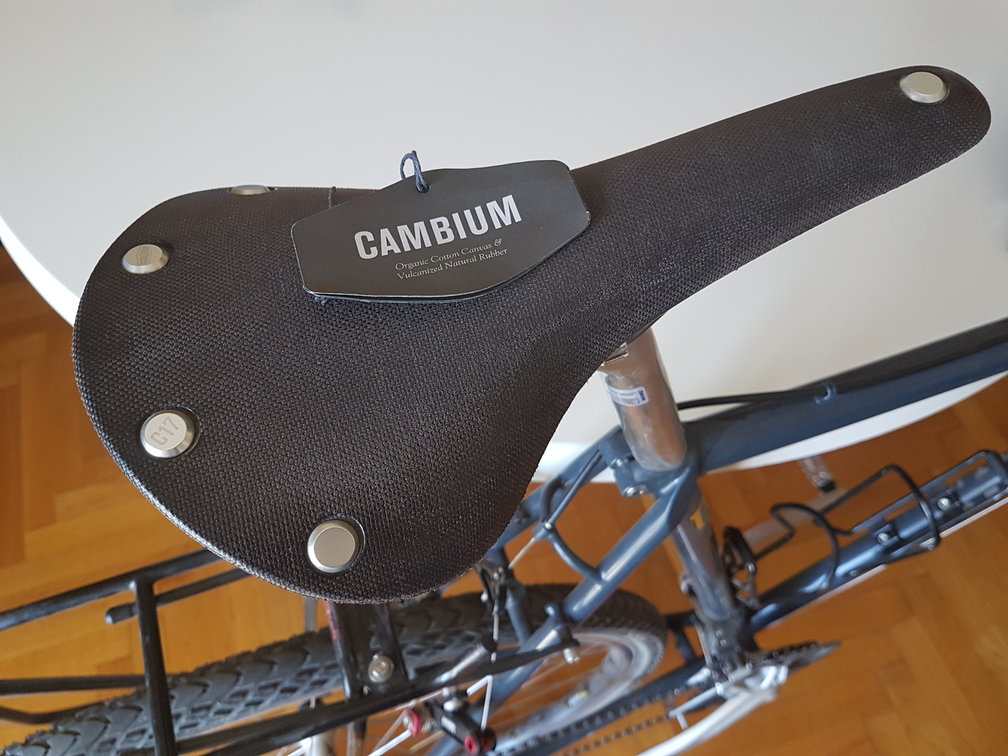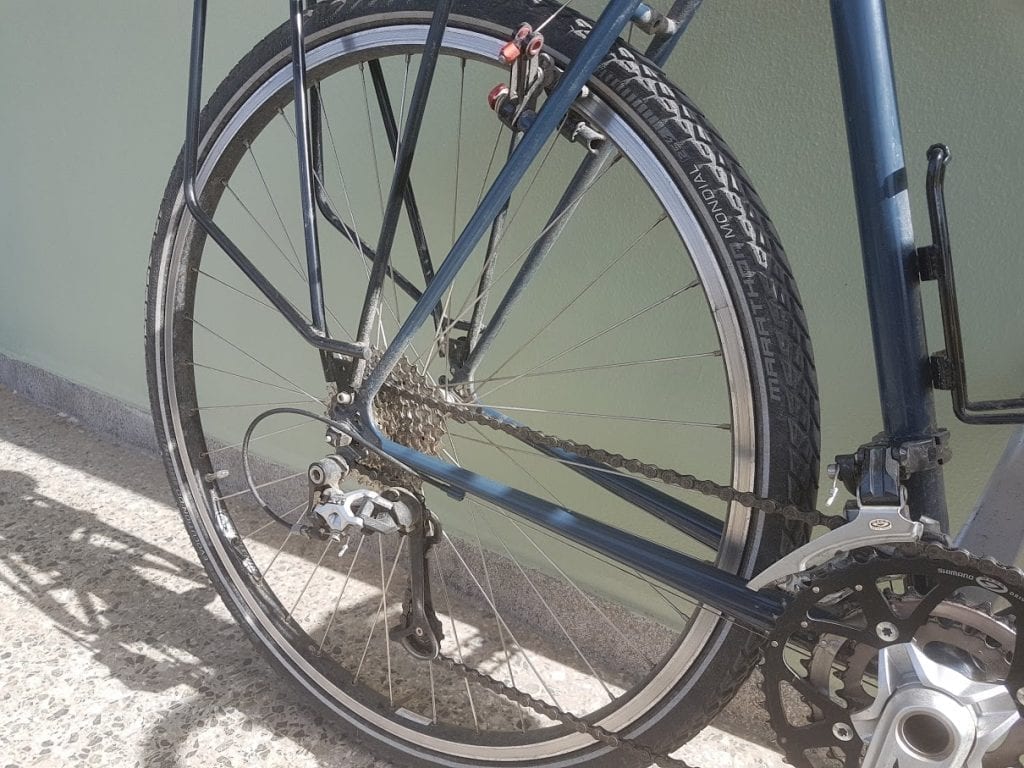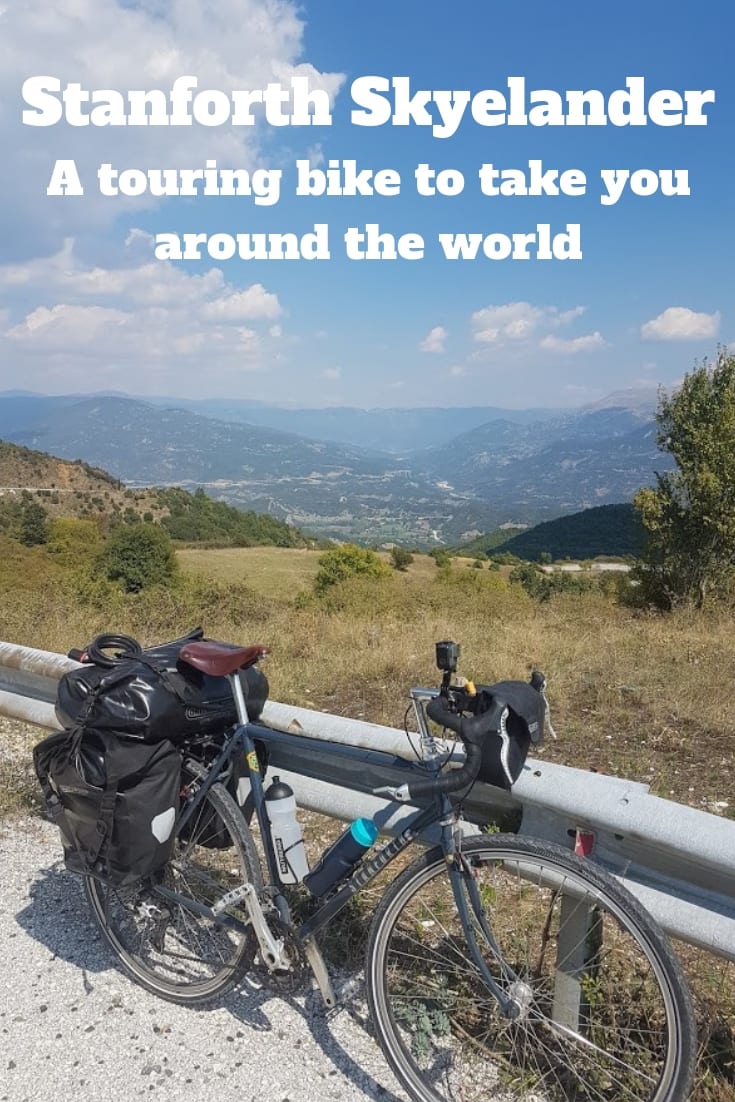After using the Stanforth Skyelander touring bike for nearly a year, it's time for a review! I've pedalled this steel frame touring bike from one end of Greece to the other on sealed roads, rough tracks, and everything in between on different cycling trips, and it's one of the best long distance touring bikes I've ever ridden. Here's why.
Stanforth Skyelander 700c Touring Bicycle

Having previously ridden one of the Stanforth Kibo+ adventure touring bikes during my long distance cycling trip from Greece to England, I jumped at the chance of testing out their latest classic touring bike design.
The 700c road tourer looked ideal for a bike trip or two I had in mind in Greece, where the routes would take me over predominantly sealed roads.
Over the course of 12 months, I clocked up somewhere between 2000 and 3000 kilometres of bicycle touring and day rides. This review of the Stanforth Skyelander is based on my personal experiences with the touring bike over this time.
Related: Bicycle travel
Classic bike for long distance bicycle touring
On first appearances, the Stanforth Skyelander looks like many other classic touring bikes. In fact, I used it as a good example of such in my video about ‘What to look for in a touring bike‘.
Perhaps it was the colour, but it doesn't seem to initially stand out in any way. And that's not a bad thing, especially if you want to lock it up outside the shops on a grocery run!
Having ridden two versions of the Stanforth Kibo 26 inch expedition bike, which were notable for being almost attention grabbing with some of their details, this was a bit of a contrast in comparison.
I think the word ‘subtle' is what I am looking for. Yes, the appearance of the Stanforth Skyelander is subtle. It's only on closer inspection that you realise that this steel touring bike has some awesome stand-out features.
Steel touring bike frame

Let's start off with the frame. The Skyelander has a lugged steel touring frame, as many of the best touring bicycles do. I prefer steel bikes for touring.
(I'm not going to discuss here whether steel touring bike frames are better than aluminium. I'll assume that you've already concluded that steel is real when it comes to a touring frame!).
There are a couple of differences though that separate the Skyelander frame from those of say a Dawes touring bike or a Surly.
Firstly, the steel is of the higher quality 631 variety. Secondly, the frame is hand built in the UK by respected frame builders Lee Cooper.
Let's not forget the forks either. I've seen several touring bikes feature forks of a lower quality steel than the frame (something to look out for!).
That's not the case with the Skyelander though, which also has 631 forks. This makes the bike incredibly strong, and basically built to last forever.
How much does the touring bike weigh?
Please note – Don't ask me about the weight! I don't know what it is, and I'm not interested. The weight of a touring bike has never concerned me.
In my opinion, anyone who wouldn't consider a touring bike because it weighs a kilogram more than another one has probably never ridden a loaded touring bike for more than a few hundred kilometres.
By the time you've packed on food and water for a few days, camping equipment, spares and other cycling gear it becomes irrelevant. You'll be looking for strength in the frame at this stage, not weight – hence the steel frame!
Drop Handlebars on the touring bicycle
The majority of touring cycles designed for predominantly road use feature drop handlebars, and the Stanforth Skyelander is no different. They offer plenty of options for hand positions, and don't flex the same way that butterfly handlebars can do.
Due to the aforementioned subtle aspect of its design, a second glance reveals a few nice touches. The first, are the bar end shifters. I far prefer these over the STI integrated shifters, as they are easier to maintain and less prone to mechanical failure.
(My Dawes Sardar had integrated shifters which failed in Mexico when I was cycling from Alaska to Argentina. In the end, a two dollar shifter saw me complete the last 10,000 kilometres of the ride!).
The second, are the rather cool looking Tektro drilled hole brake levers. The third, is the quill stem which makes it a matter of just seconds when it comes to adjusting the height of the handlebars.
The only downside to having drop handlebars on a touring bicycle, is that it reduces the amount of ‘real estate' for gadgets such as GPS and cameras. (A problem that can be solved with a little creativity).
Cambium C17 Seat

The Skyelander is available with many different options, and my particular set up had a Brooks Cambium C17 seat. I tried to get on with this seat…. I really did! In the end though, I simply didn't find it as comfortable as their classic B17 leather seat. Read my full review of the Cambium C17 seat here.
Also read: Best touring saddles
Brakes on the Stanforth Skyelander
Like many classic bicycles designed for road touring, the Skyelander I used had cantilever brakes. Now, it is fair to say that I am not a massive fan of cantilever brakes, as I find them too fiddly when it comes to maintenance. My overall preference for braking systems on a touring bicycle, are V Brakes. Hold on disc-brake fans, hear me out, and I'll get around to you!
During my usage of the Stanforth Skyelander, I had no issues with the brakes, and they worked perfectly. The Avid Shorty Ultimate cantilevers provided plenty of stopping power, which was great coming down some of the mountains here in Greece! So, overall, a good choice of braking system.
Ok disc-brake fans – I'm here! So, the reason I don't like disc brakes for bike touring, is that when you get off the beaten track, maintenance and spares become a major issue.
I'm speaking from practical experience here, and not hypothetically by the way.
HOWEVER… The Stanforth Skyelander is a steel frame touring bike designed for mainly road use. It's also most likely to be used on cycling trips in so called ‘developed' countries. As such, perhaps disc brakes wouldn't be a bad idea.
Even though I don't think it's a smart idea when it comes to actually being out there on the road, commercially it might make sense for Stanforth to provide that option!
700c Touring Bike Wheels

Good strong touring bike wheels are essential when it comes to cyclotouring, and the Stanforth Skyelander is a 29er touring bike (700c wheels).
The wheels themselves are hand built, and use Ryde Sputnik 700c 36 spoke rims with XT hubs. Again, no issues whatsoever with the wheels. If they go around, and make no strange noises, I'm a happy chappy!
As anyone who has been on a bicycle trip will attest, puncture resistant tyres are a great asset on a bike! My Skyelander came supplied with Schwalbe Marathon Mondial Performance 35c tyres, and no, I didn't have a puncture.
Thinking about it, it's been so long since I've had a puncture I should probably check the glue in my repair kit hasn't evaporated or become like concrete!
Related: Difference Between Presta And Schrader Valves
Fenders on a Touring Bicycle
I will make note of fenders or mudguards here. Some people seem to think that a touring bike is somehow naked without mudguards, or is in some way deficient if they don't have fenders!
As I use the Skyelander in nice, sunny Greece, I simply don't need them. In addition, my personal preference is to not have fenders on a touring bike.
This is due to a couple of incidents when bike touring in Alaska. I was cycling over ground so wet and clay like, that the mud would stick between the fenders and the wheels, preventing the wheel from turning.
You would really have to experience this for yourself to realise how much of a pain it is. I'm sure like me, you would take the fenders off there and then and choose to never use them again!
Transmission on the bicycle
I'll be honest here, and say that I am far from an expert on what gear ratios work best on a touring bike. If one mountain is a bit steeper than another one, I'll just put in a bit of extra leg power until the job is done.
So, when it comes to gear ratios, I pretty much leave that in the hands of the bike builder. The Stanforth Skyelander features a Shimano XT triple chainset (26/36/48) and XT rear derailleur. I can attest that this works well, as I haven't had to get off the bike and push it up a hill… so far at least!
Boring Technical Details
Here's a list of the bike's specifications:
- Frame and Forks: Lugged frame hand built in England. Reynolds 631 main frame + fork, Reynolds 525 stays, 1″ threaded steerer.
- Headset: Tange Seiki Levin 1″ threaded
- Gear Shifters: Dura Ace 9 speed (friction/index) bar end shifters
- Rear Derailleur: Shimano Deore XT
- Front derailleur: Shimano Deore
- Chainset: Shimano Deore XT triple 9 speed 26/36/48
- Cassette: Shimano HG50 9 speed 11-34
- Brakes: Avid Shorty Ultimate cantilevers
- Levers: Tektro drilled hole RRL SR (black hoods)
- Rims: 700c Rigida sputniks 36 hole black – Hand-built wheels
- Hubs: Shimano Deore XT
- Tyres: Schwalbe Marathon Mondial Performance 35c
- Stem: Nitto Technomic Deluxe Tallux 80mm stem
- Saddle: Brooks C17 Cambium black
- Pedals: VP touring
- Finish: Dusk Blue double powder coat
- Racks: Tubus rear (I never fitted the front ones)
- Tyre clearance: 700c x 45c without fenders

Stanforth Skyelander Long Distance Touring Bike Final Review
I've had the good fortune to have owned and tested quite a few touring bikes over the years. During this time, I've come to realise that each make and model has its place.
Some touring bikes are designed for the mass market, some are designed for people planning the around the world cycling trip of a lifetime, and some are built to last for years, offering great value for money over time. I believe that the Stanforth Skyelander falls into this last category.
The stand-out features for me are not just the components which go to make up the bike, but the general build quality itself. It's a bike built to last not just the next tour you have planned, but the dozen after that.
And honestly, the best feature any steel touring bike can have? It doesn't give you any problems! That makes the Skyelander a winner for me! Note – I'll also be using this during my Hercules Bike Tour of the Peloponnese in Greece.
Conclusion: Simon Stanforth has designed a traditional British tourer which is great for riding in Europe whether on sealed bike paths, dirt roads, or the occasional trail.
Find out more information about the Skyelander and other Stanforth bikes at – www.stanforthbikes.co.uk/
More Bike Touring Posts
You might also be interested in these bicycle touring blog posts:
 Article Author: Dave Briggs
Article Author: Dave Briggs
Dave has cycled around much of the world, including multi-year bike touring trips such as cycling from Alaska to Argentina, and England to South Africa. Check out his reviews and tips about bike touring.
Follow Dave on social media for travel, adventure and bicycle touring inspiration:
Great bicycle. Beautiful and classic.
But the weight is quite important for me! And I’ve been touring all my life (59 y.o). I see many with 18 kilos ‘s bike, too much for me. (14 is ok)
When you’ve have to take a train or plane or climbing stairs (yes it happens). Or just crossing the Alps.
I didn’t care when I was younger but today is different.
I have a Skylander disc and it’s basic weight is 12Kg which is excellent for a steel touring bike. Best the rider losses a few Kg in body weight to offset the benefits of strength and increased reliability.
Hello Dave, have been reading your posts with great interest. We will be cycle touring the Peloponnese for a month commencing April 14, and I see you have a route mapped out. Just wondering what sort of daily distance you think is feasible , given all I hear about Greek hills. We are experienced cycle tourists, so not afraid of hills, but don’t want to find we’ve aimed for too much distance and there is no accommodation to be had
We aren’t camping but thought we’d just wing it and see how we find the roads, hills etc and try booking hotels on the spot as we go. Or is that foolish?
Will look forward to your blogs and who knows maybe our paths will cross? We will also be cycling in northern Greece from May 24th, en route to Pogradec in Albania.
Have you cycled in that region, if so any tips, routes much appreciated.
Thx in anticipation
Hi Fiona and Andrew,
Nice to hear from you, and I hope you have a great time cycling in Greece and beyond!
Daily distances are always hard to suggest – Personally, I tend to average my days out at 80kms and accept there will be tougher days mixed with easier ones in that. Also, if somewhere I want to see comes up at 50 kms… then great!
Given the month you are cycling, I think you can be more generous with your average distances, as the temperatures won’t be the crazy 30 or even 40 degrees they can reach in the summer.
If you want to stay in affordable accommodation then hotels are ideal for you as a couple. 30 euro a night rooms or even apartments can be picked up most places, especially during off season.
If you use booking then go through this link – https://www.booking.com/s/34_6/88364550 You’ll get 15 pounds back and so will I! You can probably only use it once per email address, but if you both use it with different ones, that’s 30 quid saved on the trip 😀
I set out from Athens on April 18th, so perhaps our paths will indeed cross. There’s a lot of back and forth on my route it seems, so I’ll keep my eyes open!
I’ve previously cycled in western Greece up to Albania. I would suggest that if you have no route set in stone, to consider a crossing where you can visit the site of Butrint over the border in Albania from Greece. I made a vlog a day when cycling from Greece to England, and condensed some of them down into two videos you might find useful here:
https://www.youtube.com/watch?v=2o6_7woWP3s and https://www.youtube.com/watch?v=BypOxv-m3dk
Hope you have a great trip!
I hear you on the fenders. I had the front fender of my Trek 520 disengage and one of the posts get into the wheel, bringing me to an instant and unexpected stop. Fortunately, I landed on my head so nothing important was damaged ( 🙂 ) but I easily could have broken my phone or bike computer. Suffice to say, I am not in a rush to reinstall those fenders any time soon.
Ouch – sounds like it could have ended a lot worse depending on traffic conditions as well! Hope the bike was ok 😀